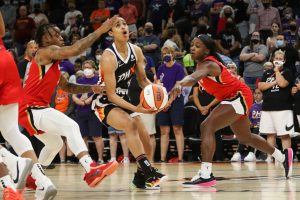- Slug: Sports-WNBA Media Rights, 900 words.
- Photo available.
By Tia Reid
Cronkite News
PHOENIX – Never in the existence of the sport has women’s basketball been bigger than it is right now, which has the WNBA looking forward to a big payday when it negotiates a new media rights deal after the 2025 season.
The 2024 NCAA women’s basketball national championship game averaged 18.9 million viewers, peaking at 24 million. It was the second-most-watched non-Olympic sporting ever in the United States. And Monday’s WNBA Draft drew 2.45 million viewers, the most ever, making it the most-viewed WNBA event on ESPN platforms.
Stars such as the newly drafted Caitlin Clark and Angel Reese and exciting veterans like A’ja Wilson and Breanna Stewart are attracting a whole new audience, rapidly shifting the media landscape of women’s basketball.
The timing couldn’t be more perfect.
Following the 2025 season, the WNBA’s broadcast media rights deal will expire and a new one will be negotiated. The WNBA’s current deal brings in about $60 million a year with games nationally televised on ABC and ESPN platforms, Amazon Prime Video, NBATV, CBS Sports and ION. WNBA Commissioner Cathy Engelbert said she aims to at least double that number in the league’s next deal.
“I think women’s media rights have been undervalued for so many years, just a microcosm by the way of the broader world that I came from before I came here,” Engelbert said before Monday’s draft. “So I think it’s really important that we’re doing everything we can.”
One proposed option is a joint deal with the NBA, whose deal also ends in 2025. At the NBA board of governors meeting on April 10, NBA Commissioner Adam Silver talked about the potential benefits of a joint deal.
He cited year-round profit due to the leagues’ opposite schedules and the potential success of combined promotion efforts as reasons why a deal including both leagues could become a reality. But with the era of engagement the WNBA is about to enter, the women’s league may not need the NBA to bolster it in finding the appropriate valuation.
“I think as you look at streamers who have a subscription model, the WNBA gives the NBA longer programming across the year,” Engelbert said. “I think Adam uses the quote of 320; I actually think it’s more days. And there’s no other set of two sports leagues that can offer that live programming and sports to a streamer like that…
“So where it makes sense to go together, we will. Where it makes sense — so we have our own deals today that the NBA doesn’t have, with Amazon, with CBS and with ION. So where it makes sense not to, we’ll evaluate that and work with Adam and his team on that.”
Whether or not the WNBA decides to partner with the NBA for the upcoming deal, this season will likely bring important benchmarks for viewership.
Clark, the Iowa Hawkeyes star who was drafted No. 1 overall by the Indiana Fever, filled up arenas and captivated unlikely audiences all throughout her collegiate career. Now, the WNBA looks to benefit from the excitement surrounding her. Monday’s draft viewership numbers are indicative of what’s to come, as are the venue changes to hold more fans for Fever road games. The Fever has announced that 36 of its 40 games will be televised nationally this season, the most of any team.
One of those games is a June 30 matchup in Phoenix against the Mercury. It will be televised on ESPN from the 18,000-seat Footprint Center that is sure to be packed with fans anticipating Clark’s arrival.
The Mercury have 25 other games that will hit national airwaves, including their season opener at the home of the defending champion Las Vegas Aces on May 12 on ESPN2 and a June 16 home bout televised on ABC that will mark Skylar Diggins-Smith’s return to the Valley with the Seattle Storm.
Riveting matchups are taking center stage around the league this year as all 12 teams work collectively to put their best foot forward and promote the WNBA as a product for potential partners.
“This is an important year for us around viewership, around attendance, around all the qualitative and quantitative factors that go into the valuation of media rights,” Engelbert said. “Because as I’ve said to my team, there’s not a day that we’re not — if we’re not working on things that feed into the valuation of our next media rights, we’re not focused on the right things.”
How this year transpires directly affects the league’s future. A stellar year of viewership brings in more money and more eyes that will lead to a better media rights deal in 2025. With more money coming in due to increased sponsorships and broadcast deals, the WNBA will be able to solve issues like charter travel and bring in more expansion teams.
Speaking to the media before the draft, Engelbert set a goal of 16 total teams by 2028. Increasingly emergent interest in the league would go a long way in helping prospective cities like Philadelphia, Toronto, Portland, Denver, Nashville and South Florida secure the ownership funding and stadium deals to be approved for a new team.
This year will set the tone for the WNBA for many years to come both on the court and off it. How the WNBA capitalizes off the expected growth will give a preview into the future of what the league could be and just how high up its ceiling can be.
“It was just a few years ago we were surviving,” Engelbert said. “And now we’re going from survive to thrive.”
For more stories from Cronkite News, visit cronkitenews.azpbs.org.

(File photo by Harrison Zhang/Cronkite News)